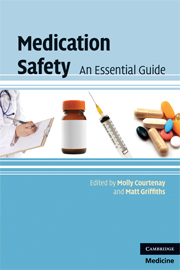Book contents
- Frontmatter
- Contents
- List of contributors
- Preface
- 1 Introduction to medication errors and medication safety
- 2 Safety in prescribing
- 3 Safety in dispensing
- 4 Safety in administering
- 5 Adverse drug reactions and drug interactions
- 6 Interface of care and communication
- 7 Parenteral drug administration
- 8 Calculations
- 9 Controlled drugs and patient safety
- 10 Reporting medication errors and near misses
- 11 Ensuring safety through evidence-based medicine
- Index
- References
11 - Ensuring safety through evidence-based medicine
Published online by Cambridge University Press: 22 January 2010
- Frontmatter
- Contents
- List of contributors
- Preface
- 1 Introduction to medication errors and medication safety
- 2 Safety in prescribing
- 3 Safety in dispensing
- 4 Safety in administering
- 5 Adverse drug reactions and drug interactions
- 6 Interface of care and communication
- 7 Parenteral drug administration
- 8 Calculations
- 9 Controlled drugs and patient safety
- 10 Reporting medication errors and near misses
- 11 Ensuring safety through evidence-based medicine
- Index
- References
Summary
Introduction
To offer our patients high quality and safe care, we must be prepared to base our decisions on the best available evidence, continually evaluate our own practice and seek to improve it, learn from unexpected incidents and errors (whether these are our own or others'), and share uncertainty with our patients and the NHS (to help prioritise the research agenda). In this chapter I outline the principles of evidence-based medicine, briefly mention some of its limitations and describe how it can help you practise safely. The chapter focuses on therapeutic interventions, but it is important to be aware that evidence-based medicine can support safe practice in other ways, for example, by informing you about the accuracy of diagnostic tests, the prognosis of a condition, and the causes and risk factors for a disease.
Evidence and evidence-based medicine
What is evidence?
In its broadest sense evidence is information that is used to support the truth of a recommendation or conclusion. Evidence is found in a wide variety of sources such as published research, expert opinion, patient experience and audit data.
What is evidence-based medicine?
Evidence-based medicine has been defined as the integration of best research evidence with our clinical expertise and our patient's unique values and circumstances (Straus et al., 2000).
- Type
- Chapter
- Information
- Medication SafetyAn Essential Guide, pp. 173 - 192Publisher: Cambridge University PressPrint publication year: 2009

